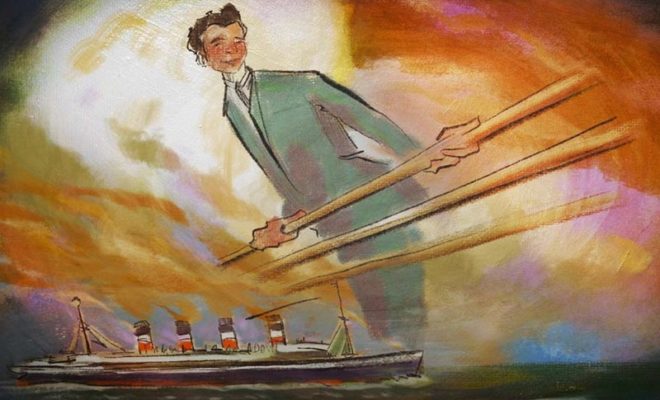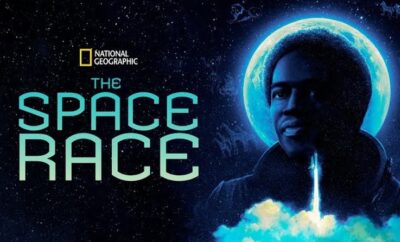
Movie Reviews
Coded
By: Kelly Kearney
Director Ryan White’s new documentary short about illustrator J.C. Leyendecker lands at the AFI Film Docs Festival just in time for Pride month. Leyendecker, a working gay artist during the early part of the 20th century, laid the foundation for modern-day LGBTQ+ representation in advertising. With his coded LGBTQ+ images tipping their hat to a community forced to live in the closet, Leyendecker managed to turn the heteronormative consumer into a gay ally long before equality came to the “Land of the Free.”
Looking back on queer history
When it comes to history, you are hard pressed to find examples of LGBTQ life outside of the occasional offensive stereotype, but at the start of the 20th century queer imagery crept its way out of the underground and into pop culture thanks to one artist: J.C. Leyendecker. Endlessly talented at an early age, Leyendecker dreamed of making a living as an artist. As a teen looking to expand his knowledge, J.C. boarded a ship bound for Paris, a far cry from his Chicago upbringing. In the early 1900’s the Parisian city was the place to be for any struggling artist hoping to make it big. Artists and musicians from all over Europe flocked to the city for inspiration. And with experience and travel, J.C.’s skills gained depth and praise. It was a decision that led him to his true passion: advertising. At the time print ads and art nouveau, with their informal messaging and glossy consumerism, adorned every bustling corner and shop in the city. It was a full court press of economic flourishment and Leyendecker was about to ride that wave to stardom thanks to a little company called Arrow Collars and Shirts.
When Leyendecker returned from Paris the imprisonment of famed gay author and poet Oscar Wilde, for his “unnatural” acts of sodomy, was all the talk in the literary and art world. J.C. and the millions of his fellow queer Americans were faced with an ever-tightening grip on puritan values. To be openly gay was unheard of, but that didn’t stop Leyendecker from imbuing gay coded subtext in all of his work. When his contractual work with the Arrow Shirt Company hit the advertising scene, his depiction of the perfect Arrow man turned heads from both men and women alike. With their perfect features and muscular physiques, the “Arrow Man” became the prototype for masculinity; every man wanted to look like the Arrow Man and every woman dreamed of marrying him. Unbeknownst to the general public, Leyendecker used subtle looks, touches and poses, like a wink and a nod to anyone who recognized gay tropes and behaviors. Two men gazing at each other during a game of golf, a tight grip on a club, a line of vision connecting eyes to lips and various poses that easily hid his agenda beneath the muscular sportsmanship of every ad he drew. His ability to sell gender variances and same sex attraction to the mainstream heteronormative consumer was like sugar in a spoonful of medicine that helped the queer acceptance go down. It also led him to a decade’s long partnership with the popular New York based magazine, The Saturday Evening Post. Between the years 1896 and 1950 Leyendecker created over four hundred magazine covers, with three hundred and twenty-two gracing the front page of famous New York Weekly. He went from starving artist to socialite, hosting parties in his New Rochelle mansion with his model muse and partner Charles Beach. Famous attendees like author F. Scott Fitzgerald and fellow artist Norman Rockwell were usual faces at the Leyendecker/Beach soirees. But all parties must end and with the rise in McCarthy’s communist red fear mongering in post-WWII America, Leyendecker’s work took a hit. Artists in every field were either labeled traitors or shoved out of the spotlight in fear of the long-armed reach of an out-of-control justice department. The queer community was the first to be attacked by this new hard right grip on the nation and The Saturday Evening Post, following suit, was no longer interested in his covers dripping with queer subtlety. Pop culture and the “othering” of anyone whose differences stood out led to the eventual replacement of J.C. for the nuclear family artist, friend and former student Rockwell. As the years ticked by, J.C. became a veritable unknown and his work was lost in the shuffle of the changing times, but what his art did for the future of queer representation could not be shoved back into America’s closet. It was out, it was proud and it was inspiring representation in all forms of print media to this day.
Queer Representation Today
With interviews from art historians mixed in with queer artists and models of the 21st century, Coded pays its respects to the work of J.C. Leyendecker by highlighting how far queer culture and representation has come since the days of the Arrow Man. “I guess if I had to live it all over again, I might have done it differently…but maybe I couldn’t have,” Leyendecker was quoted saying and in that bravery to stay true to himself was born a movement that opened the door for people like trans Calvin Klein model Jari Jones to be themselves, and to see themselves represented in billboards, fashion runways and advertisements across the world was partly thanks to the initial steps taken by artists like Leyendecker. Clips and interviews of queer models and advertising CEOs for brand companies like lesbian-friendly Subaru bridged the gap between the historical relevance of Leyendecker’s work and present-day inclusion.
Director Ryan White’s doc also does its due diligence in explaining how the hetero gaze of Leyendecker’s covers gave birth to what many would call quintessential Americana. Those homoerotic covers depicting a rosy-cheeked Santa Clause or the fireworks of Independence Day became not only a moment of cultural acceptance but also cemented itself as the inspiration for almost all of our most cherished holiday traditions today. It is in its respect for the past that Coded finds itself embraced by the queer community today. Diving deep into the research of a man history actively forgot was made harder after his death due to his lifelong partner, Beach, burning all of his work. It was a request from a dying man who never wanted to be outed, but thanks to historians like author Judy Cutler, White was able to include some existing pieces as well as letters written by the artist into the film. This goldmine, as well as voice overs of Leyendecker provided by out actor Neil Patrick Harris was how the artist was brought to life on screen. Rich with history on one of the queer community’s most inspiring icons, Coded is must-watch for anyone who yearns to live their truth with the hope that it can motivate the world to change.




You must be logged in to post a comment Login